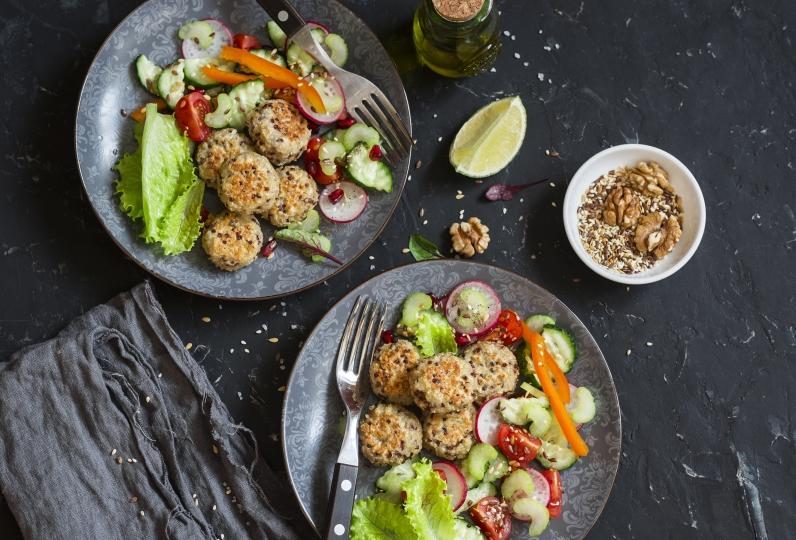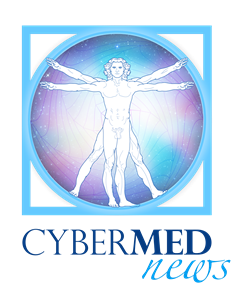 Share on Facebook
Share on Facebook

If you're prone to feeling stressed out, this diet will produce all the natural brain chemicals that can calm you down and boost your brain power, says psychotherapist Dr Mike Dow
Using food as self-medication is the most socially acceptable way to drug yourself. We all know that pints of ice cream put Band-Aids on worries and broken hearts. But sugar can be a disaster for your brain. It's vital for all of us to reduce the blood-sugar spikes lurking in all the tempting food most Westerners are presented with 24/7.
As your waistline grows with blood sugar-spiking foods, your hippocampus shrinks. This is a part of the brain that helps you remain resilient in the face of stress and helps regulate mood by controlling your sympathetic and parasympathetic nervous system. It's also the part of the brain where the most neurogenesis, the growth of new brain cells, occurs.
We now know that sugar and other blood sugar-spiking foods can wreak the same havoc on the hippocampus as trauma or extreme stress. The result: high levels of brain drainers like cortisol, which, in turn, can also lower levels of feel-good hormones like serotonin.
In 2015, the first human study demonstrating an association between diet and hippocampus volume was published. This study looked at people who followed a "prudent" diet versus the blood sugar-spiking "Western" diet.
The prudent diet was associated with a larger hippocampus, and the Western one was associated with a smaller hippocampus.These relationships held true even when accounting for other variables like education or physical activity levels.1
The solution: cut foods with a high glycemic index or load and replace them with lower glycemic-index or -load foods.
The antioxidants found in vegetables and whole fruits help protect the hippocampus from losing volume by combating oxidation—another process that can shrink this part of the brain.
Vegetables and whole fruits are also rich in cofactors—the specific vitamins and minerals your brain needs to make its two primary stress relievers: serotonin and GABA. This is important because healthy levels of serotonin and GABA help you feel more optimistic and peaceful. You're less likely to engage in self-medicating behaviors like eating carbs alone in front of the TV and more likely to want to engage in healthy behaviors like exercise and connection with loved ones.
Tryptophan
Tryptophan is the amino acid that your body converts into 5-HTP and then soothing serotonin with the help of the cofactors folate, vitamin B6, vitamin C, zinc and magnesium. Since serotonin is later converted into melatonin, it can also help you sleep better at night.
Where to get it: chia seeds, sunflower seeds, flaxseed, pistachios, cashews, almonds, hazelnuts, peanuts, soy beans, tofu, tempeh, cheese, buckwheat, wheat bran, wheat germ, quinoa, beans, salmon, cod, perch, meat, eggs, granola, milk, yogurt, chocolate, avocado, bananas, tamarind
Glutamine
Glutamine is the amino acid precursor to one of your body's main brain-soothing chemicals: GABA. Like other amino acids, it is essential for protein synthesis. By eating whole foods containing amino acids as part of a healthy, well-rounded diet, including the cofactors magnesium and vitamin B6, you will bring your body and nervous system back into blissful balance.
Where to get it: beef, chicken, pork, fish, eggs, beans, cabbage, kale, parsley, beets, Brussels sprouts, dairy, milk, quinoa, almonds, pistachios, walnuts, seeds, peanut butter
Vitamin B6
Stress can lower vitamin B6 levels, so getting enough of it is vital when you're feeling drained. B vitamins are stress-relieving powerhouses, and vitamin B6 is essential since it acts as a cofactor for two brain-balancing neurotransmitters: serotonin and GABA. It helps your body to convert 5-HTP, which is manufactured from tryptophan, into serotonin, and the amino acid glutamine into GABA.
It's also involved in the production of melatonin, which helps promote sleep—this is why some melatonin supplements also contain B vitamins. Vitamin B6 is essential to your nervous system and supports the healthy function of your adrenal glands, which can drain or balance your brain.
Where to get it: carrots, spinach, peas, bananas, sunflower seeds, pistachios, lentils, chickpeas, salmon, shrimp, turkey, beef, pork, milk
Folate (also known as vitamin B9)
Stress also lowers levels of folate. Folate is a B vitamin that helps your brain convert the tryptophan in your diet into 5-HTP, which is then converted into calming, feel-good serotonin. Folate also helps to support healthy adrenal function. The naturally occurring folate found in vegetables and beans is more effective and better for you than the folic acid added to cereals and other carbs.
Where to get it: spinach, Brussels sprouts, kale, romaine, mushrooms, asparagus, bananas, melon, lemons, Swiss chard, broccoli, lentils, black beans, kidney beans, black-eyed peas
Vitamin B12
In animals, gut bacteria produce this vitamin, which we digest when we eat animal products or seafood. A vitamin B12 deficiency can cause depression, fatigue and weakness. In addition to relieving stress, vitamin B12 may also help improve sleep by resetting circadian rhythms.
Where to get it: beef, salmon, sardines, mackerel, eggs, milk, yogurt; for vegans and vegetarians, consider fortified cereals, fortified soy, or a food-based nutritional yeast like Red Star Nutritional Yeast. Vitamin B12 is light sensitive, so store fortified yeast in a cool, dark place.
Thiamin (also known as thiamine or vitamin B1)
Like the other B vitamins, thiamin is essential in supporting the nervous system and adrenal function. It can help support the immune system when it's fighting stress, while also helping to keep cortisol levels in check. Thiamin deficiencies, though less common than vitamin B6 or B12 deficiencies, can cause irritability, nausea and fatigue.
Where to get it: beef, pork, chicken, milk, oranges, nuts, seeds, wheat germ, wheat bran, rice bran, brewer's yeast, oatmeal
Magnesium
Forty-eight percent of Americans don't have enough magnesium in their diet.2 Magnesium can have a calming effect on the brain as well as the body and promote restful sleep. It can also help prevent cortisol spikes.3
Where to get it: broccoli, squash, spinach, beet greens, collard greens, Swiss chard, cashews, almonds, sesame seeds, black beans, coffee, salmon, halibut
Vitamin C
Vitamin C helps your body turn the 5-HTP manufactured from tryptophan into serotonin. In one study, over 100 people were exposed to a stressor. Those who had been on a two-week course of vitamin C (1,000 mg, three times a day) had their cortisol levels return to normal more quickly, with smaller blood pressure increases, compared with those who had taken a dummy pill instead.4
Besides balancing cortisol levels, vitamin C helps to bring cortisol levels back up should they be too low, which can be true for atypical or extreme patterns of a drained brain.5
Where to get it: red and yellow bell peppers, chili peppers, acerola or Barbados cherry, papaya, guava, kale, strawberries, raspberries, oranges, melon, grapefruit, tangerines, blackcurrant, apricots, plums, parsley, kiwi, broccoli, spinach, cauliflower, Brussels sprouts, lychee, elderberries, pineapple, garlic, limes, tomatoes
Zinc
Zinc acts as a cofactor that helps your body turn 5-HTP into serotonin. The highest concentration of zinc in the body is in the brain's hippocampus, which, as you know, is the part of the brain that can help us remain resilient and harbors new brain cell development.
Getting enough zinc is also essential for proper function of your adrenal glands. It may be lacking in many vegetarian diets since many of the richest sources are animal products, which also contain a form of zinc that is more bioavailable.
Vegetarians may need to get slightly more zinc or increase bioavailability of the form in plant-based foods by soaking beans, grains and seeds in water before
cooking them.
Where to get it: oysters, beef, crab, bison, lamb, pork, turkey, chicken, yogurt, pumpkin or squash seeds, baked beans, tempeh, lentils, kidney beans, chickpeas, black-eyed peas, split peas, pine nuts, peanuts, cashews, almonds, sunflower seeds, cashew butter, natural peanut butter, tofu, fortified breakfast cereals, oatmeal, flounder, sole
Choline
Choline is a nutrient that helps support brain function. It is metabolized into acetylcholine, the primary balancer of the parasympathetic nervous system, which brings stress hormone levels back down after a spike. Choline also helps support healthy levels of the brain balancer GABA.
Where to get it: egg yolk, beef, almonds, avocado, broccoli, Brussels sprouts, cucumber, zucchini, flaxseed, soy, shrimp, wild salmon, cod, peanut butter, chocolate
Calcium
Calcium is the most abundant mineral in the body, but deficiencies are common, affecting the majority of Americans, both men and women, and this can lead to anxiety.
One reason that calcium deficiencies are so common is that you also need sufficient levels of vitamin D—another vitamin most people are deficient in—to efficiently absorb calcium. And since vitamin D is fat soluble, you also need healthy levels of fats to absorb enough vitamin D to then absorb calcium.
Another problem is that phytic acid and oxalic acid, found in some plants like collard greens, spinach, beans and seeds, can inhibit calcium absorption. Vegans tend to eat many more plant products containing these two acids, which may be why vegans have been shown to have more bone fractures than people who consume meat and dairy.6
One natural fix: cooking vegetables can neutralize the oxalic acid that prevents calcium absorption.
Where to get it: yogurt, cheese, sardines, milk, fortified soy milk, calcium-fortified orange juice, tofu, salmon, turnip greens, kale, cabbage, broccoli, walnuts, almonds, pecans
Theanine (also known as L-theanine) and EGCG (epigallocatechin gallate)
These two stress-fighting powerhouses are found in everyday teas made from the Camellia sinensis plant. Theanine is an amino acid, and EGCG is a flavonoid.
Theanine calms the electrical activity associated with brain drain, produces brain-wave states similar to those found in people who meditate, and can help modulate the fight, flight or freeze response. It can help lower blood pressure while boosting levels of brain-balancing GABA and reducing levels of brain-draining norepinephrine. EGCG also helps promote healthy levels of GABA while reducing cortisol levels.
Where to get it: Theanine is found exclusively in tea. The richest source of EGCG is also tea, but small amounts are found in some nuts like pecans and hazelnuts. Look for black, oolong, green and white teas, which all come from the Camellia sinensis plant.
If you're not sensitive to caffeine, enjoy a variety of these teas, since some have more theanine while others have more EGCG.
If caffeine is too activating for you, favor decaffeinated teas or white teas. Black tea has the most caffeine, followed by oolong, then green, then white. Higher-caffeine teas like black tea have more theanine; less caffeinated teas like white and green tea have more EGCG. Both compounds can help to relieve stress. Avoid milk and sugar in tea. Milk, even soy milk, has been shown to blunt some of the health benefits of tea by binding to and neutralizing the antioxidants.
Zucchini Spaghetti with Tomato Sauce and Walnut 'Meatballs'
Serves 4
2 large zucchini
1 batch Raw Tomato Sauce
1 batch Walnut 'Meatballs'
Nutritional yeast, to taste (optional)
1) Use a spiralizer or vegetable peeler to make spaghetti strips with the zucchini. Place in bowls.
2) Evenly divide the Raw Tomato Sauce and 'Meatballs' between the
bowls and sprinkle nutritional yeast, if desired, on top.
Raw Tomato Sauce
Serves 4
2 large tomatoes
1 cup sundried tomatoes
1 clove garlic
¼ red or yellow onion
1 Tbsp extra virgin olive oil
¼ tsp black pepper
¼ tsp chili flakes or cayenne pepper
1 Tbsp fresh basil or ½ Tbsp dried basil
½ tsp dried thyme
½ tsp dried parsley
½ tsp dried oregano
Add all ingredients to your blender and mix for one minute or until well combined.
Tip: Soak the sundried tomatoes for one hour to make the blending process easier and the sauce smoother.
Walnut 'Meatballs'
You can make raw tacos by wrapping up a few of these 'meatballs' in lettuce with the toppings of your choice. They also go well on a bed of brown-rice pasta, bean pasta or zucchini pasta. Serve with dipping sauce and organic corn chips for a great party snack.
Serves 4 to 6
1½ cups walnuts
1 cup sundried tomatoes
2 Tbsp extra virgin olive oil
1 tsp dried sage
1 tsp fennel seeds
1 tsp dried thyme
1 tsp dried rosemary
1 tsp dried oregano
1 pinch black pepper
1 pinch cayenne pepper
1 pinch salt
1) Add all ingredients to your blender and mix for five minutes or until well combined. The mixture should be moist and
stick together.
2) Roll mixture with your hands to make 'meatballs.'
Tips:
• I f you do not have a blender, you can use a mortar and pestle to crush the walnuts. Then dice the sundried tomatoes and mix everything together in a bowl.
• For a nut-free version, use pumpkin seeds or sunflower seeds instead
of walnuts.
• If you use essential oils instead of dried herbs, be sparing. Start with just the amount of oil you get when you dip a clean toothpick in the bottle, then increase to taste.
Grass-Fed Beef Tacos
I love tacos and grew up eating them once per week. I love to top mine with avocado, grated carrot and lettuce. It's very important the beef is high-quality grass fed, so it is good brain food; if it's not, the beef is often contaminated with hormones, antibiotics and genetically modified foods.
Serves 3 (2 tacos each)
Filling:
1 Tbsp extra virgin coconut oil, for cooking
1 pound ground beef
1 tsp salt
1 tsp cumin
1 tsp turmeric
1 tsp garlic powder or 1 Tbsp garlic, minced
1 tsp onion powder
½ tsp paprika
¼ tsp black pepper
Dash of cayenne pepper
Choose your shell
6 organic taco shells
6 tortilla wraps
6 lettuce leaves
Choose your toppings:
Nutritional yeast
Organic cheese, grated
Carrots, grated
Lettuce, shredded
Avocado, cubed
Peppers, diced
Fresh cilantro (coriander) leaves
Black beans, cooked
Vegan sour cream
Mango salsa
Ketchup
Taco sauce
1) If you are choosing taco shells, bake them in the oven at 350°F for five minutes.
2) Meanwhile, heat a large frying pan with oil and add the beef. Use a wooden spoon to break up the beef.
3) Add all of the spices to the beef and stir.
4) Cook for eight minutes or until done.
5) Wrap the meat in tortilla wraps, taco shells, or lettuce leaves. Add the toppings of your choice.
All recipes are from Liana Werner-Gray, the author of The Earth Diet and 10-Minute Recipes
Adapted from Heal Your Drained Brain: Naturally Relieve Anxiety, Combat Insomnia, and Balance Your Brain in Just 14 Days by Dr Mike Dow (Hay House, 2018)
References
1 BMC Med, 2015; 13: 215
2 Nutr Rev, 2012; 70: 153-64
3 J Clin Chem Clin Biochem, 1984; 22: 717-21
4 Psychopharmacology (Berl), 2002;159: 319-24
5 Int J Sports Med, 2001;22: 537-43
6 Eur J Clin Nutr, 2007; 61: 1400-6
https://www.wddty.com/lifestyle/2018/03/the-diet-to-boost-brain-power-and-reduce-stress.html?utm_source=Boomtrain&utm_medium=email&utm_campaign=enews_02102018&utm_term&utm_content&bt_ee=vLpx8tbjf%2B1vzFkjXHCjR76mBPo856TLqI9SnuDTR92H%2FJutMKJuYzs27lmd8gDu&bt_ts=1538475521984



